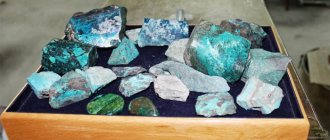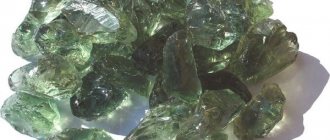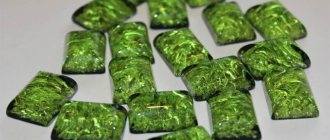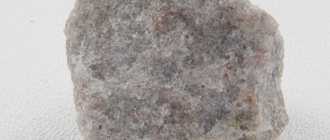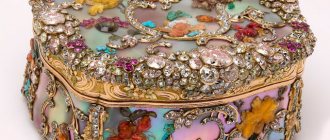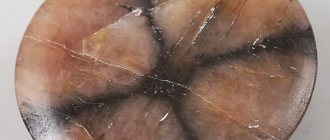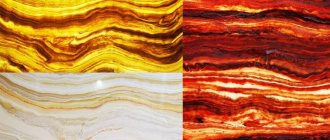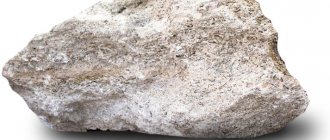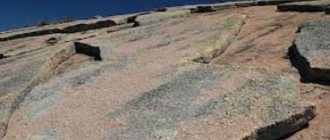What does the stone look like?
For a mineralogist, cacholong is a type of ordinary base opal with quartz or chalcedony in its composition. The agglomerates are opaque, slightly shimmering with mother-of-pearl. They look like milk, porcelain, slightly greenish or bluish enamel.
The translucency of impeccable whiteness equates cacholong with elite varieties of porcelain. For this, he is especially appreciated by the inhabitants of the Middle Kingdom.
The mineral is formed shallow from the surface at normal pressure and temperatures. But for cacholong to appear, like any opal, it requires water. It is a mineral of sedimentary origin.
Historical reference
In India, cacholong is still considered the petrified milk of cows; in ancient times, this stone, identified with sacred animals, was also considered sacred. According to legend, the stone was formed from the udder of cows, turning into stone when falling to the ground.
Buddhists associated cacholong with the lotus, a flower of purity and tenderness. Since ancient times, Buddhists have used this stone to create amulets for women in labor and little girls. This stone has also served as a symbol of purity since ancient times in Mongolia.
But the nomadic tribes of the steppes were not the first to discover this beautiful stone. Long before them, in Ancient Egypt, he was associated with the cult of Osiris and Isis. Another belief claimed that cacholong was the sacred gem of the bull god Apis. White stone was used to make jewelry, figurines, and mosaics by masters of Ancient Greece and Ancient Rome.
After the fall of the Roman Empire, white opal was forgotten in Europe. Its popularity was only revived in the eighteenth century. The gem, brought from India, won the hearts of English jewelers. Beads, rosaries, and bracelets began to be made from it. Stone craftsmen appreciated the beauty of the mineral and the ease with which it can be processed.
There are poetic images comparing this stone with the eternity and incomprehensibility of the Milky Way.
Origin story
In the languages of the Turkic group, crystals are called differently - kashilon. This translates as "river". The term "cacholong" appeared in India when the Mughals conquered the country. Mongolian and Turkic tribes were sure that white opal appeared at the site of the drops of the sacred river.
Subsequently, the belief changed in India. There, the origin of the mineral was associated with the milk of sacred cows that lived at Indian temples.
However, this gem was discovered not only by nomadic tribes. The ancient Egyptians associated cacholong with the cult of Isis and Osiris. It was also believed that this was the stone of the bull god Apis. Gems were used to make figurines, jewelry, and mosaics. Such products were created back in Ancient Rome and Greece.
When the Roman Empire was destroyed, the stone was forgotten. It only gained popularity again in the eighteenth century. This gem came from India to England and literally conquered all jewelers. The mineral began to be used to create bracelets, beads, and rosaries.
Colors and varieties
Since semi-opal is a hardened mixture of chalcedony and opal, gemologists, depending on which of these minerals predominates in the composition of the gem, distinguish two varieties:
Cacholong chalcedony
An opaque stone with highly pronounced porosity, painted milky and having many shades.
Among this variety of gemstones, there are often specimens with beautiful gray veins. It is he who is most often used to create all types of jewelry.
Cacholong opal
A softer and more delicate stone, the pure white color of which is due to a large number of micropores filled with air and creating the effect of light scattering.
Individual specimens containing impurities of manganese, calcium oxide and iron acquire darker shades with yellow, black, red, orange or brown stains.
This type of cacholong is devoid of bright shine. It is characterized only by a muted glass shimmer.
The main colors of cacholong are milky and white, but experts estimate that these colors can have at least a hundred shades.
Semi-opals found in nature are most often:
- black;
- greenish;
- bluish;
- grayish;
- ivory;
- with a purple tint;
- honey-white;
- gray;
- with brown specks;
- white, with veins, as well as gray or black inclusions.
Difference from other stones
Cacholongs are often counterfeited, especially minerals containing more chalcedony than opal, as they are more expensive. Natural cacholongs are distinguished from other stones as follows:
- The radiance of natural gems changes depending on the viewing angle. Fakes made of plastic or glass give a uniform shine.
- Pay attention to the pattern. Natural cacholong is unique, different in each specimen. It is extremely difficult to fake such a drawing.
If the jewelry has already been purchased, but there are doubts about the naturalness of the stone, sometimes they do the following:
- Touch the gem with your tongue - the real one should stick slightly.
- They throw it into a glass and wait. This is a risky test. A real mineral first swells and then cracks.
Authenticity is established using special equipment. To avoid mistakes, turn to expert jewelers and buy jewelry in trusted stores.
Cacholong has served man for thousands of years. It is a beautiful and useful stone, and people still appreciate it. Jewelry with a gem will be a good talisman for an expectant mother or a woman trying to get pregnant. A mineral with good and bright energy should be protected from water and high humidity.
Physical and chemical properties
From a chemist's point of view, the cacholong mineral is silicon oxide. (SiO)2 is the main component of its formula.
| Selection form | collomorphic cluster-shaped, stalactite sinter aggregates, . It occurs in the form of nodules of irregular, isometric, flattened shape, their surface is often ribbed, kidney-shaped with a polygonal system of drying cracks, as well as in the form of lenses and veins |
| Color | milky white, honey white (yellowish), sometimes with a grayish tint |
| Transparency | opaque |
| Hardness | 5,5 |
| origin of name | from the Kalmyk words kahe - river and halong - stone |
| Zodiac sign | Taurus, Libra |
It is a hardened solution of opal or chalcedony. Depending on the dominance in the composition, opal cacholong and chalcedony cacholong are distinguished. Cacholong opal is softer, more delicate, the abundance of micropores creates the effect of light scattering. It is pure white, the shades are characteristic of the chalcedony variety.
Physical properties
The mineral consists mainly of calcium, but there are also other impurities interspersed with natural creations. The formation process is complex and cannot be repeated in laboratory conditions. It requires wood from centuries-old trees, a huge amount of liquid, great pressure and a certain temperature.
Also read: Angelite - blue angel stone
Formation takes place in areas with arid climates. The first excavations were recorded in Asia. Then the breed began to be found in other countries, the characteristics were identical everywhere.
Properties of the gem:
| Property | Description |
| Formula | SiO2*nH2O |
| Density | 2.1 g/cm³ |
| Mohs hardness scale | 5,5–6,5 |
| Color | milky white, sometimes with a greenish or bluish tint. |
| Strength | afraid of reaction with water. |
| Structure | porous. |
| Structure | fragile. |
The rock goes through various processes, microscopic transformations and biochemical reactions. Samples are formed according to their own laws. Some of them become strong and are not afraid of moisture. Such samples have a smooth surface and even parts of the chips. Others are porous and unstable to moisture.
The stone has the following shapes:
- porcelain;
- enamel.
According to the chemical formula, the mineral is silicon dioxide hydrate. This is opal with chalcedony. When viewed under a microscope, cacholong consists of thin and flat fibers tightly pulled together into a single piece.
Place of Birth
Cacholong in the Geological Museum of Kiev University
As mentioned above, cacholong is a mineral of sedimentary origin. Formed at normal temperatures and pressures, shallow from the Earth's surface. Water is needed for its formation.
This stone is mined on many continents:
- Eurasia - Iceland, Russia, India, Kazakhstan, Armenia, Turkmenistan, China, Mongolia.
- North America - USA.
- Australia (provides half of the raw materials entering the world market).
In Russia, there are deposits of it in Eastern Siberia, Transbaikalia, Kalmykia, and Stavropol Territory.
Meaning for humans
Ring with cacholong
For modern people, the main meaning of pearl opal comes down to its use as an ornamental stone, the best examples of which make magnificent jewelry.
Cupronickel, silver and costume jewelry alloys are most often used to frame inexpensive gemstones. Products in gold frames are made to order.
Recently, a mysterious mineral that can be easily processed has begun to attract the attention of specialists involved in high fashion.
In 2021, the Italian jewelry house Vhernier released a line of crocodile leather jewelry handbags. One of the models in this collection has a removable handle made of cacholong and 18-karat white gold.
Medicinal properties
If you decide to use a mineral for healing, do not ignore the treatment prescribed by your doctor.
The healing properties of cacholong are manifested in the following:
- The state of the nervous system is normalized.
- Metabolic processes in the owner's body improve.
- After contemplating the stone, a person recovers his strength faster after physical activity or a hard day at work.
- Helps in curing women's ailments.
In order for the patient to recover faster after surgery or a serious illness, you can place a cacholong product or a raw stone near him.
Cacholong earrings
Healers and lithotherapists advise wearing the following jewelry with this mineral for various health problems:
- Earrings with a greenish stone - for high eye pressure and eye diseases.
- A ring or ring on the left hand enhances sexual activity, on the right hand it helps restore reproductive functions.
To enhance the healing properties of cacholong, the ring with it should be worn alternately on different fingers, and the bracelet on different hands.
Bracelets will help spouses find the lost feeling of love.
Pendants or long beads help relieve gastrointestinal pain. You can also drink water infused on the stone (it should not have a greenish tint).
Therapeutic effect
The healing properties of cacholong help a person on a physical and emotional level:
- The stone relieves women's ailments, including infertility.
- Useful for men. A ring or ring with a stone on the left hand enhances potency. On the right - increases the ability to conceive.
Healers prescribed cacholong powder to spouses who had lost mutual interest. Today it is enough to wear mineral bracelets.
- Contemplation of the stone quickly restores the body after a hard day at work or physical exertion: increased strength, normalized muscle tone and blood pressure.
- Earrings with greenish cacholong lower eye pressure, treat glaucoma and other eye diseases.
- The product or raw stone is placed near the patient for speedy rehabilitation or after surgery.
- Long beads or pendants relieve gastrointestinal pain. You can drink water infused with white (without greenish) mineral.
White cacholong normalizes the state of the nervous system: it calms spontaneous anger and excitement. The stone brings out depression, instilling peace and harmony in a person.
Cacholong product
Magic properties
The magical properties of cacholong are capable of:
- To attract a “soul mate” to a person suffering from loneliness: to do this, the ring with the stone should be put on your left hand.
- Free your owner from aggressiveness and causeless anxiety.
- Sharpen your intuition and ensure cash flow.
- To protect married couples from mutual infidelity (in this case, it is recommended to wear a ring with a gem on the right hand).
- Promote the emergence of useful acquaintances: to achieve this goal, the stone must be kept with you at all times.
- To empower politicians, teachers, doctors and lawyers with justice, wisdom and the ability to understand and respect other people.
Cacholong pendant
A gem will be able to fully reveal its magical properties only if it suits its owner according to the zodiac sign.
It is recommended to change the position of the mineral regularly: bracelets and rings should be alternately put on different hands, periodically refusing to wear beads and earrings.
People involved in magical practices claim that in winter and autumn the power of the gem increases noticeably.
Sudden yellowing of white cacholong may occur due to negative effects on its owner.
The affected pebble should be cleaned immediately. If color restoration does not occur after this, you need to get rid of the jewelry that has absorbed the evil.
Cacholong for men
For representatives of the stronger sex, such a stone helps in the treatment of inflammatory diseases and gaining self-confidence, masculine strength, and overcoming psychological pressures. For those who suffer from various complexes and lack of self-confidence, experts advise wearing a bracelet on the right hand made of this type of opal, and for those who are often sick, applying the stone to the inflamed area - this will help not only relieve negative symptoms, but also get rid of a sore throat , stomach, intestines and cleanse the body as a whole.
- Cacholong increases the body's endurance;
- Helps to quickly recover from illness and restore strength;
- Helps relieve nervous tension;
- Helps a man become stronger sexually;
- Promotes healthy offspring and longevity;
- Helps create strong relationships with others, especially women;
- Promotes relaxation;
- Helps those for whom this stone is suitable to achieve success.
Talismans, amulets, amulets
- Pearl opal, symbolizing motherhood and considered a feminine stone, is recommended to be used as a talisman or amulet for pregnant women, nursing mothers, teachers, pediatricians and educators. However, men can also count on the gem’s help: pacifists, priests and rescuers.
- Owning a cacholong amulet can sharpen its owner’s intuition or develop psychic abilities.
- Cacholong, which carries a powerful charge of positive energy, is unsuitable for black magic rituals. Any attempt to use it to cause damage or cause any harm can result in a whole flurry of failures falling on the head of the customer or performer of the ritual. That is why it is recommended to use it as a talisman that can protect the owner from dark energy and any external negativity.
- For ordinary people, a semi-opal talisman can become a real money magnet. For investors, a gold ring with cacholong will ensure the successful completion of risky operations related to investing capital.
- Amulets and talismans made of pearl opal can take the form of rough stones, jewelry, figurines of deities, or birds and animals symbolizing them. The energy of the talismans, which reaches its peak at the time of the first frost, lasts until the end of February.
- Amulets with half-opal should be kept close to you: on the body or in front of the eyes. It is recommended to pick up the figures as often as possible.
- Women who want to attract love will be helped by constantly wearing a bracelet, a heart-shaped pendant or a ring (it should be worn on the left hand). It is advisable to place paired figurines of doves or swans in the house.
- A figurine of a stork carved from cacholong will speed up the birth of children.
- A figurine of a calf placed at the entrance to a house will protect it from the penetration of evil forces and ensure the material well-being of all its inhabitants.
Cacholong stone. Properties, features and application of cacholong
Frozen milk. This is the name of the mineral found in the steppes of Kolmykia. The name of the stone was given there. In the local dialect it sounds like " Kakholong ". "Kahe" is the name of the river where the mineral deposits were discovered, and "halog" is the stone. The comparison to milk originated in India. It is associated with the appearance of Cacholong. It is white, opaque, with thin streaks of gray.
Physical properties of cacholong
If it contains impurities of iron, manganese, calcium oxide, cacholong stone can be yellow, orange, reddish, brown, green, blue and even black. The mineral does not have a bright shine; its radiance is muted, reminiscent of the shimmer of glass.
On the Mohs scale, the hardness of cacholong is about 6. This is one position less than quartz, but still above average. Although it is not easy to scratch a stone, it is easy to break. Cacholong is fragile and requires careful handling and operation.
The photo shows a cacholong stone in its raw form, found in the steppes of Kolmykia
The mineral has no cleavage. When the stone is broken, there are no smooth surfaces left. This is a property of all opals, the base form of which includes cacholong. Most of its varieties are not resistant to water. The stone is porous, quickly absorbs moisture and cracks.
Features of cacholong formation
Cacholong is formed in the surface layers of the earth's crust. The mineral either precipitates from solutions or arises as a result of biochemical processes.
Stone formation requires standard temperatures and pressures. There are three common forms of occurrence of cacholongs. The first is the nodule. These are round-shaped formations. The second form is a lens.
The photo shows earrings made of 585 white gold with cacholong inserts
This is the name for a mineral concentration that is compacted in the center and thin along the edges of rounded lines. Cacholong veins are also found. They are not extended. The maximum length is 40-50 centimeters.
Typically, the veins range from 3 to 20 centimeters. Lines of drying out are always visible on mineral formations. The stone is formed during the process of water loss.
The paths of its exit are the same veins on the cacholong. Chalcedony is often embedded in the veins. From the point of view of geologists, cacholong is half chalcedony, half opal.
Cacholong deposits
Based on the Asian origin of the name of the stone, its main deposits are located in the East. Deposits are being developed in Kazakhstan, India, China, Russia, and Armenia. Since cacholong requires a lot of water to form, there is plenty of stone in Iceland.
Application of cacholong
The surface of cacholong resembles porcelain. In this regard, the mineral is actively used for the production of vases, decorative items, and dishes. The stone is used in furniture production. The main source of stone consumption is jewelry making.
Cacholong is the least expensive type of opal, although it is considered precious. This makes white crystals a popular ornamental raw material. Ease of processing is also a plus. However, only those types of cacholong that are resistant to water are used. There are only 3 of them.
The healing properties of cacholong
The properties of cacholong stone depend on its color. Colorful variations have a beneficial effect on the functioning of the digestive system. Traditional healers and lithotherapists “prescribe” the mineral for ulcers, gastritis, increased acidity of gastric juice, even constipation or diarrhea.
The photo shows a cacholong necklace
White cacholong specimens are considered female. The stone is recommended to be worn in the abdominal area during pregnancy. Then it will proceed without complications and childbirth will be easy. Kacholong helps with all women's ailments. The mineral cures infertility, bacterial and viral diseases of the reproductive system.
The photo shows a silver ring with cacholong
Another purpose of cacholong is to calm the nervous system. The stone relieves depression, nervousness, and overwork. In addition, wearing crystals cleanses the body, activating the process of removing toxins from it.
In India, cacholong is also prescribed for high eye pressure. Eastern doctors advise patients to peer at the stone for a long time, then the pressure will return to normal.
Magical properties of the stone
Magical properties began to be attributed to cacholong in Ancient Egypt. At that time the stone did not have an official name. It was indeed later given to the mineral by the Kalmyks. However, although without a name, the mineral was known to people.
The Egyptians considered it a symbol of the God Apis. He was depicted as a bull and was considered responsible for fertility, health and financial well-being. The cacholong brings these benefits to the life of its owner.
The photo shows a 585 gold ring with cacholong and colorless diamonds
Crystals are not able to affect others. The energy of the stone is directed only towards its owner. Esotericists claim that cacholong takes on the owner’s emotions, strengthening them. Because of this, the mineral is contraindicated for two zodiac signs.
It makes Aries even more hot-tempered and enhances the gloomy mood of Scorpios. Cacholong has maximum compatibility with Libra and Pisces. Crystals bring them material benefits and good luck in all endeavors.
Talismans and amulets from cacholong
As a talisman, cacholong is indicated for all people whose profession is related to the health and well-being of others. These professionals include doctors, lawyers, teachers and politicians.
Since the mineral helps to bear a child, it is considered an amulet for pregnant women and those planning to have children. Cacholong also helps during breastfeeding. If you wear a pendant with a white stone in the neckline, lactation increases.
The photo shows a white gold bracelet with cacholong and pearls
In order not to change the talisman every single day, you will have to monitor it properly. Cacholong does not tolerate exposure to cosmetics, steam and ultrasound. Clean the stone with a weak solution of laundry soap or just a cloth. It can be either dry or wet.
Areas of application
Silver earrings with cacholong
Cacholong is an ornamental stone that lends itself well to cutting and polishing, therefore, in addition to jewelry, it is used to make dishes, carved tiles, sculptures and figurines, boxes, panels, and parts of expensive interior decor.
The healing properties of the mineral are widely used by lithotherapists, healers, doctors of alternative medicine and bioenergy.
The magical properties of semi-opal help people involved in astrology and esotericism.
How to use and care for the attribute
It is not enough to know who the stone is suitable for according to their zodiac sign and what magical properties cacholong has. Caring for the attribute is of great importance. If you do not follow the rules, the healing and magical qualities will weaken.
Cacholong jewelry is usually made round or oval. Only silver is used for framing. It is this metal that perfectly emphasizes the unusual shade. To make jewelry, combinations with turquoise or jasper are used. From an energy and aesthetics point of view, this is an ideal solution.
A simple care system will preserve the healing properties of the mineral. Please note that the stone is quite fragile, so interaction with other jewelry may cause mechanical damage. Products made from Kashilon should be stored separately, wrapped in cloth.
Friction and impacts negatively affect the condition of the stone. Aggressive household chemicals are not for this mineral. To clean, just use water and soap. Experts also recommend periodically wiping jewelry with a cloth soaked in olive oil.
Decorations and prices
Jewelry makers like the gem. They insert them into all types of jewelry.
- Brooches with white crystals will amazingly decorate light-colored fabrics and sparkle brightly on dark ones.
- Bracelets will change your hands, make them soft and young.
- Beads made from white peas look great at any time of the year.
- Earrings add airiness and charm to a woman's image.
White cacholong necklace
Jewelry is made from round and oval shapes. The gem is placed in silver. White color and silver shade are an excellent combination. You can buy a piece of jewelry from several crystals of different types. Turquoise, jasper, amazonite, and malachite are combined with the stone.
The material is used to prepare items for the interior, decoration of walls, floors, and street buildings. The price of the items is affordable, it depends on the type and finish of the gems. Simple stones from 5 to 30 dollars. Master's name rings go up to $300 and even more.
There are tips on how to wear and buy jewelry correctly:
- rings and rings - on the middle finger;
- the day of a successful purchase is the 18th lunar day;
- You should not put it on immediately, but on the 4th day, first the jewelry should get used to the owner;
- exhibits properties more clearly on Fridays.
The gem is passed down from generation to generation as a family heirloom, then its powers increase significantly.
How to properly care
You need to care for the mineral in the same way as for opals:
- It is protected from shocks, falls, and strong compression.
- Cacholong placed in water absorbs it. Once dry, it may crack. Therefore, jewelry is removed before water procedures, going to the pool, or to the beach.
- Contact with perfumes, cosmetics, and household chemicals is excluded. The porous structure of the stone will quickly absorb all this, destroying the mineral.
- Ultrasonic cleaning is contraindicated. Only by hand, with warm water, neutral soap and not for long. You can drop a couple of drops of olive oil onto a napkin.
Carefully!
Jewelry is given a separate box in a room with a constant microclimate: changes in temperature and humidity are dangerous for cacholong.
How to wear
Necklace made of natural cacholong
Thanks to its color, cacholong goes well with clothes of any shade. Jewelry with it can be worn in sets.
In bracelets, necklaces, and beads, this mineral goes well with hairy quartz, rose and smoky quartz (rauchtopaz). Turquoise and malachite are also suitable for cacholong with a light green tint.
Esotericists advise wearing rings, rings, bracelets alternately on one hand and then on the other. It is better to wear the ring on the middle finger.
If the mineral turns yellow, this means that the owner has been subjected to negative energetic influence from other people. The decoration can be cleaned. If cleaning does not help, it is better to put the product in a secluded place and not wear it.
How to recognize a fake
Ring with imitation cacholong “Milan”
Only natural specimens have the magical and healing properties of cacholong stone, so you need to be able to distinguish a fake. To do this, it is best to carefully study photographs of pearl opal and jewelry with it. However, unfortunately, this may not be enough. Some scammers, with skill worthy of better use, imitate the appearance of the crystal. In this case, there are other ways to bring them to clean water.
- Touch the gem with the tip of your tongue. The tongue sticks a little to natural stone, like to iron.
- Cacholong is a hygroscopic material, that is, it is able to absorb water. You shouldn’t keep it in a glass for too long: the mineral begins to swell and then crack.
- If you expose white opal to the sun's rays, it begins to sparkle with a dull, almost imperceptible glow.
- The most important feature of cacholong, which cannot be faked using cheaper materials, is glare. The shine of the stone changes depending on the angle at which you look at it. Glass or plastic fakes always have a uniform shine. The unique mesh pattern on river opal is also almost never possible to imitate.
Chalcedony cacholongs are most often counterfeited - their price is higher than that of opal ones. If you are still unsure whether you bought a real stone or a fake, contact a specialist.
Jewelry equipment allows you to establish authenticity with one hundred percent probability. To avoid unnecessary worries, purchase gems only in specialized shops.
How to spot a fake
The mineral is not particularly expensive or popular, but it is counterfeited. Fraudsters are lured by the uniformly white surface, which is easy to replicate.
Howlite, marble, glass or synthetics are often offered under the guise of stone.
To identify the nature of the sample, take into account what natural cacholong looks like:
- Its structure is hidden crystalline - unlike marble.
- The surface is always uniform: veins or spotting are attributes of howlite.
- A few dotted darkish inclusions are acceptable, but they indicate a lower quality of the mineral.
- The color is milky white, sometimes greenish or bluish. A pink, black, lilac or other colored specimen is either a tinted cacholong or some other gemstone. The easiest way to check this is on beads: you can see the colored layer near the hole.
- The surface of the stone is smooth, “soft”, matte. May resemble porcelain or enamel. With a light pearlescent sheen, which, unlike glass or synthetics, changes when turned.
It is not for nothing that Buddhists compare the purity of the stone with the satin radiance of a lotus: translucent whiteness is the main aesthetic feature of cacholong.
- A simple way to distinguish a real mineral from a fake is to apply a sample to your tongue. Super-hygroscopic cacholong will immediately stick, and the person will feel a slight tingling sensation.
The production of synthetic stone has been established legally. Many sellers honestly pass it off as “imitation” or “artificial”. Products with it, especially a massive bracelet or sautoir, look no worse than natural ones. Although they are useless for magical or medicinal purposes.
Compatibility with other stones
Cacholong enhances magical properties:
- rhodonite;
- lapis lazuli;
- malachite
Pearl stone is beautiful in combination with all types of quartz. Preferred varieties are smoky, pink, hairy.
Jewelers combine cacholong with turquoise. Stones of a delicate light color are often used. Greenish and bluish varieties of cacholong are good to accompany them.
In appearance and magical properties, semi-opal is combined with white agate and dendro opal.
Who is suitable according to their zodiac sign?
Ring with natural cacholong
According to astrologers, cacholong is suitable for:
- Taurus. For them, it can become a talisman that can improve their financial situation and ensure good luck in all their endeavors.
- Pisces. The influence of the gem will help strengthen their healing abilities, thanks to which people of this sign will not only be able to diagnose other people's ailments, but will also gain an intuitive understanding of how to treat them, but they should use this gift only for the benefit of their patients.
- Sagittarius. They can use the stone as a talisman that can protect them from all sorts of adversities and dangers.
- Cancer. Very vulnerable and tender inside, representatives of this zodiac sign seem uncommunicative and callous to others. This is often the cause of serious conflicts. Under the influence of pearl opal, Cancers will gain the ability to adequately express their feelings.
- Leos. Cacholong will bring them luck and material well-being.
- Capricorns. By enhancing the best qualities of representatives of this sign, the gem will help them achieve their goals faster.
- Virgos. Cacholong will attract success, health and financial independence to them. Relationships with children will develop harmoniously.
- Gemini. A talisman with a pearl opal will make them purposeful, courageous, decisive, and confident in their own abilities.
- Libra. With the help of cacholong, they will learn to quickly make the right decisions, be able to save a large sum of money and create a strong family (including confirmed bachelors).
- Aquarius. For them, the gem will become a powerful amulet that protects against negative energy emanating from sorcerers and envious people.
You should refuse the help of cacholong:
- Scorpios, since the influence of the gem can complicate their already difficult character.
- Aries. Possession of a semi-opal can strengthen their inherent negative traits (primarily aggressiveness), due to which their relationships with others often do not work out.
Sources and literature
- M. Loiri, “Wonderful stones. 250 minerals: history, properties and hidden features." Publishing house: EKSMO, 2021, 384 pp.
- V. Dobrov, “Healing energy of stones. Crystal therapy for beginners" Publishing house: St. Petersburg: IG "Ves", 2021, 176 pp.
- A.V. Milovsky, O.V. Kononov, “Mineralogy”, 1982
- H. Askinosi, T. Jandro, “The Magic of Stones and Crystals.” Publishing house: EKSMO, 2021, 304 pp.
- Fersman A.E., “Entertaining mineralogy”, 1975
5 / 5 ( 3 voices)
